Compositions of succulents: features, types, layout principles
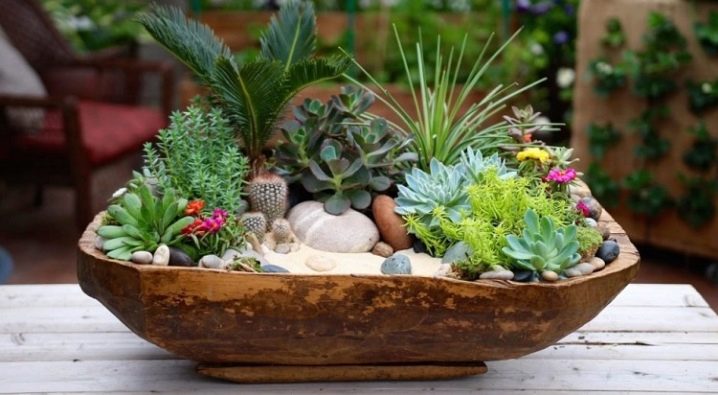
Many people use different colors for interior decoration. Interesting compositions and original design solutions look especially beautiful, and not chaotically placed pots. Recently, the cultivation of succulents and the creation of the most unusual compositions from them has become popular. This fascinating business has its own characteristics, principles of layout, and there are also special types of compositions.

What it is?
Succulents are plant species that have the unique ability to store water in their tissues. Therefore, they are adapted to an arid climate. Succulents come in 2 varieties.
- Stem accumulate moisture in a thick stem, the leaves of such plants are most often very small or they are thorns. These varieties include the bulk of cacti and some types of milkweed.
- Leafy accumulate moisture in dense thickened leaves. Of these succulents, aloe, lithops, haworthia, echeveria are especially popular.
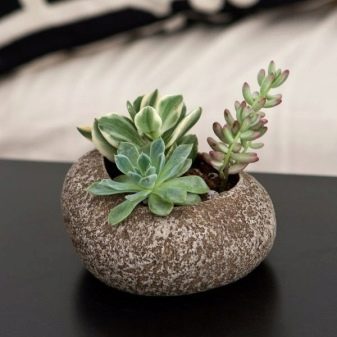

It is from these specimens that succulent growers make chic compositions and decorate entire zones. Unique feature hold moisture for a long time greatly facilitates the care of plants. They are especially readily used by people who, for various reasons, cannot regularly take care of plants, for example, because of frequent business trips.
Succulents are so convenient in this regard that you can completely leave on vacation and, upon your return, find your pets safe and sound. And if it so happened that the plants did not receive water for a long time, another feature saves them: the top may die, but new stems will grow back when watering.
When decorating housing with these plants, it must be borne in mind that the juice of many of them is poisonous, and the surface of some species is covered with thorns or thorns.
Therefore, when working with them, you need to act carefully, it is better to protect your hands with gloves.
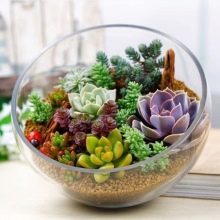
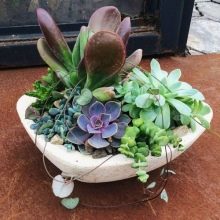
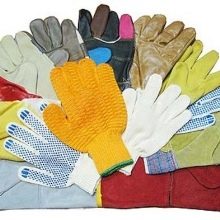
Varieties
Long gone are the days when a cactus was sadly gathering dust in a pot and did not represent anything attractive. Now florist designers and lovers of these species have learned to create real miracles and create mini-gardens at home using plants and various decorative elements.
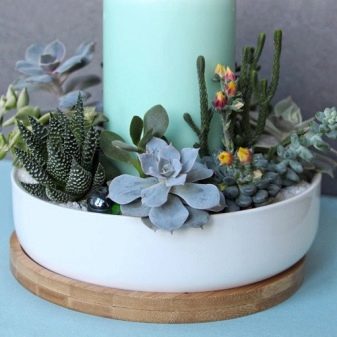
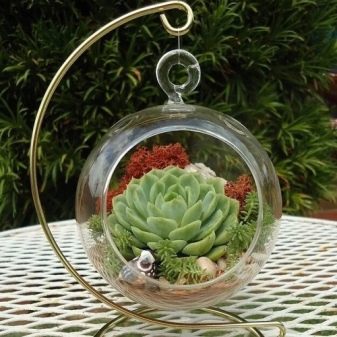
Phyto paintings
To create a living picture, need a frame, which should be deeper than those for ordinary paintings. Everyone chooses Rama according to their taste. In a horizontal view, it will be a flat box, at the bottom of which there is plywood, and along the edges there are sides.
Next, the substrate is laid in which the flowers will grow, and a metal grill is placed on top... Thus, each plant will have its own cell. Considering that succulents have a wide variety of colors, you can create a very beautiful picture and feel like an artist painting with real flowers.
A small succulent is sent to each cell. When all the cells are filled, it is necessary for the painting to settle in a horizontal position for 2 weeks. After the plants take root, you can place your DIY masterpiece on the wall. Periodically, the picture can be sprayed or organize monthly watering, after removing it from the wall.
After watering, it is better to leave it in a horizontal position for several hours, and then return it to the wall.
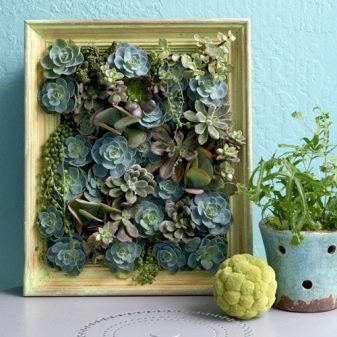
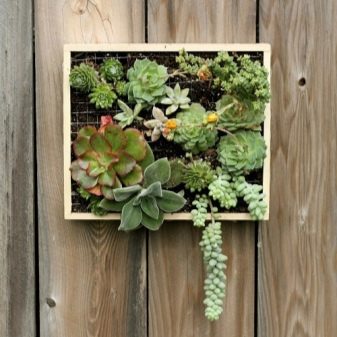
Panel
A panel of living plants is the same picture. And the manufacturing principle is exactly the same. You can add decorative elements as desired, and also choose a different shape. For example, make a very narrow horizontal or vertical design, round or oval.
If someone has a desire to make a panel of dried plants, then they simply attached to the base with glue or varnish, from above they can also be varnished. Such panels do not need care at all, but they perfectly decorate the interior.
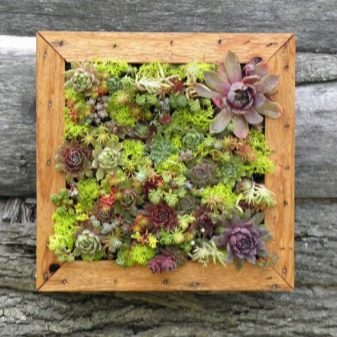
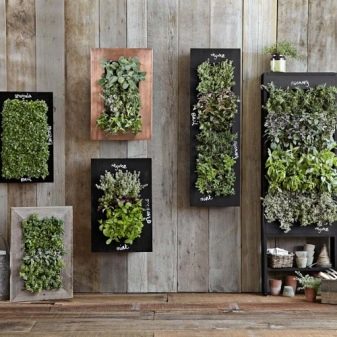
Compositions in pots
Everyone has the opportunity to equip their own miniature garden at home. To do this, it is enough to pick up several suitable pots and plant plants in them. You just need to decide on the shape and color of the pots and the types of plants that will decorate the composition. They can be placed on any surface and even on the floor. In addition, a mini succulent garden can be made in one large pot.
Many miniature plants of different shades and types will create a wonderful composition.

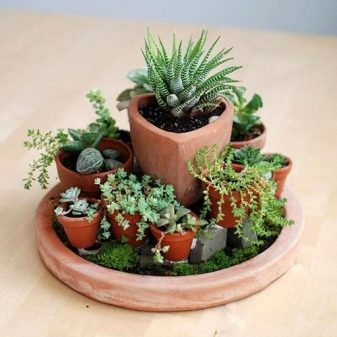
Florariums
Succulents in glass look especially interesting and original. Florariums most often created in aquariums... They look very nice in a round aquarium. Several types of plants are planted in it, supplemented with stones and other design elements to your taste.
You can install such a glass vessel anywhere. It will decorate the window sill, but not from the sunny side, and the chest of drawers, and the shelf, and the coffee table.

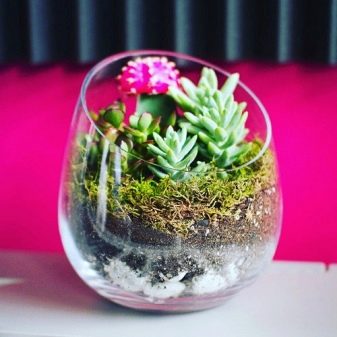
Layout principles
To assemble a composition in a pot or glass vessel, one main principle operates: you need to imagine this composition and know how it should look, and not spontaneously place plants in a container. Anyone can make a composition, even a novice florist. It is performed step by step:
- first, you should choose a container in which the mini-garden will be placed: one pot or several small ones, an aquarium or other glass vessel, a picture frame or a flat box;
- then drainage is laid, a substrate is placed in which the plants will be comfortable;
- then the plants are placed in the selected container in the order that was determined in advance so that they are combined in colors, sizes and correspond to the intentions of the artist who creates this small work;
- the final touch will be additions in the form of pebbles, twigs or small snags, hemp, sand and other decorative elements.
Plant selection
Choosing plants for one composition, you must follow the rules.
- We must focus onso that succulents have the same requirements for soil, watering, sun. Then the composition will be easy to take care of, and it will delight the eye for a long time.
- If the growing zone the selected plants have approximately the same or their habitats are in the same climatic conditions, then their neighborhood in the composition will be successful.
- When choosing components you need to ensure that too large specimens do not take food and moisture from small ones and do not harm their root system.
- Not recommended add a lot of mosses to the composition, since they have the property of retaining a large amount of moisture on the surface, which can damage the succulents. You can add very little moss for decorative purposes.
- Use you can use such succulents as sedum, rejuvenated, cotyledon, graptopetalum, argyroderma, aptenia.
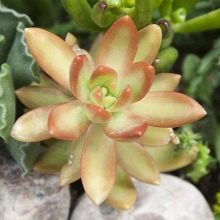


The choice of capacity and substrate
The choice of capacity depends on the selected composition. If you use a lot of small and varied plants, then it is better to arrange it like a painting or place it in a flat box... If you want to focus on 2-3 species, you can place them in an aquarium or glass vase, decorating with additional elements. When creating an entire garden, it is better to place succulents in separate pots and arrange them so that they complement each other and decorate the space.
Succulents look good in earthenware... In addition, there are original solutions: plants can be placed in a wide glass on a thin leg, in an elegant high-heeled shoe, in a huge shell, in a beautiful box. Some make a garden in a piece of a sawn tree trunk. A real natural corner looks very beautiful and natural. The inside and outside of the wood must be treated with a water-repellent coating or special varnish.
Before planting plants, the bottom of any container must be laid out with stones. This will be the drainage. Then a layer of charcoal is needed. It is great for preventing the appearance of fungi. Next, the sand is mixed with a nutritious soil composition.
You will often find potting potting soil specially made for succulents in garden stores.

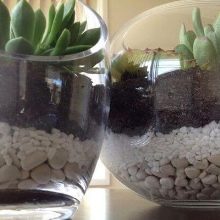
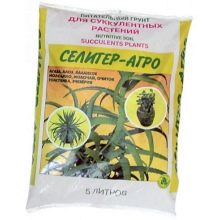
Use of decorative elements
Decorative elements will be an addition to any composition. When all the succulents have taken their places, you can think over the design. You can use everything that is available at home. It all depends on the chosen topic and the imagination of the compiler. If nothing was found at home, all decorative elements can be purchased at florist shops.
This can be, for example, pebbles, the colored ones look good. You can paint them yourself and cover them with a protective varnish. Fine sand looks great, including colored sand. Small and medium-sized shells will do, large beads in the form of pearls. Even small figures can be placed in the aquarium and vases, which will fit into the overall picture.
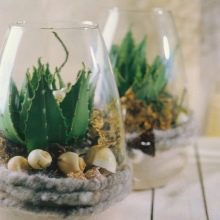
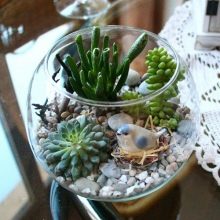
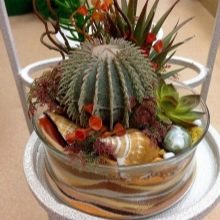
Care
Home care for these types of plants is so easy that any florist will cope with them.
- Proper maintenance begins with soil selection. If drainage is done, coal, sand and nutrient mixture are present, the plants will take root well.
- It is often not necessary to fertilize them. Top dressing should be applied in the spring and the emphasis should be on nitrogen fertilizers.
- Transplant plants are also needed in the spring.
- Watering is done once every 2 weeks. in summer and spring days, gradually reducing the amount of watering for winter. At this time, it is enough to water them once a month.
- Succulents tolerate heat and drought well, but in hot weather it is worth spraying them sometimes.
- They love the sun but it is not always necessary to keep them on windowsills in direct sunlight all day, it is better to keep them a little aside.
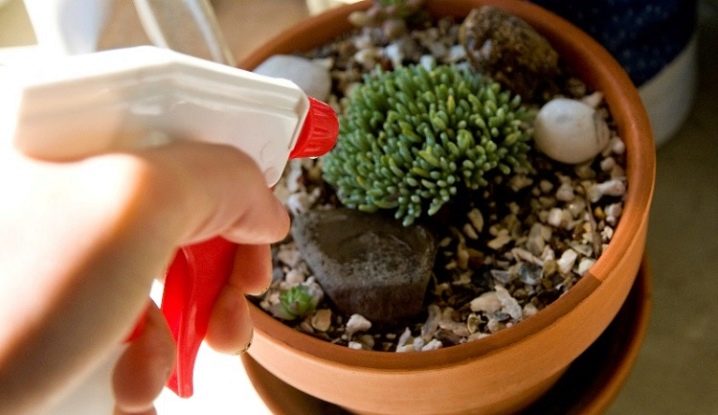
Beautiful examples
Compositions can be very diverse.
- Such a wonderful corner can be created in a flat round container. A wooden house, colorful pebbles and small animal figures are perfect for succulents.
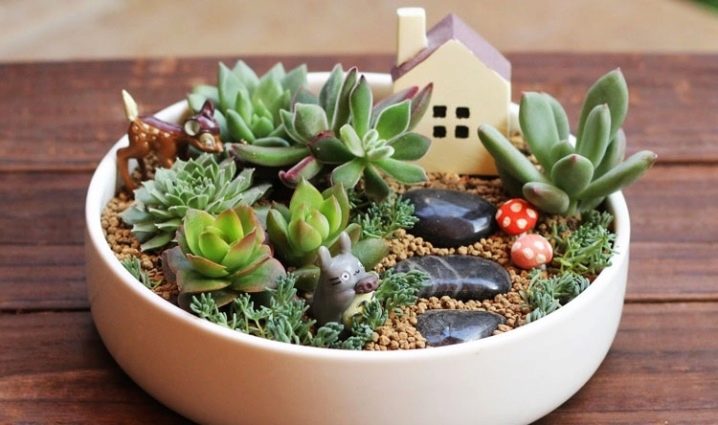
- A lovely rural landscape unfolds before your eyes in a wooden container with a fence and small cows. But the main elements of the composition are miniature plants of various colors.
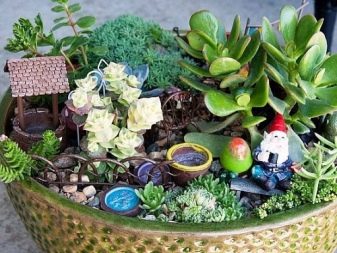
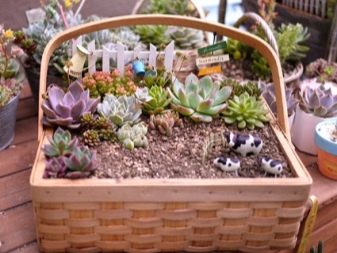
- Unlimited imagination will certainly prompt different options for interesting solutions: you can create an amazingly stylish composition even in an ordinary bank.
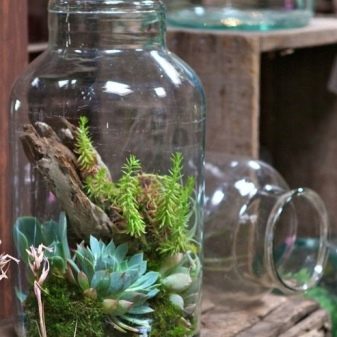
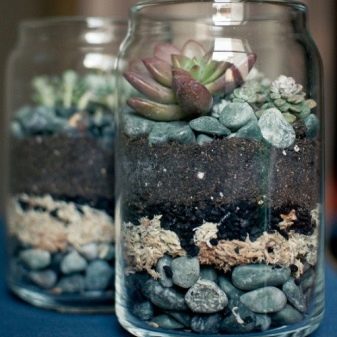
- With the help of succulents, you can make any thematic compositions, including New Year's ones. It is enough to add a few bright touches, for example, in the form of candles and balls.

You can find out how to make a mini-garden of succulents with your own hands by watching the video below.























































The comment was sent successfully.